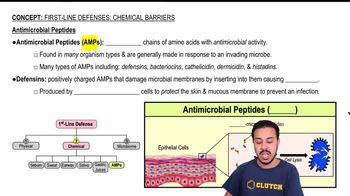The thermal death time for a suspension of Bacillus subtilis endospores is in dry heat and less than in an autoclave. Which type of heat is more effective? Why?
The antimicrobial effect of gamma radiation is due to (a) ________. The antimicrobial effect of ultraviolet radiation is due to (b) ________.
 Verified step by step guidance
Verified step by step guidance
Verified Solution
Key Concepts
Gamma Radiation

Ultraviolet (UV) Radiation

Mechanisms of Antimicrobial Action

If pasteurization does not achieve sterilization, why is pasteurization used to treat food?
Thermal death point is not considered an accurate measure of the effectiveness of heat sterilization. List three factors that can alter thermal death point.
A mixed culture of Escherichia coli and Penicillium chrysogenum is inoculated onto the following culture media. On which medium would you expect each to grow? Why?
a. 0.5% peptone in tap water
b. 10% glucose in tap water
Differentiate cellular and plasmodial slime molds. How does each survive adverse environmental conditions?
Match the following choices to the culture descriptions in questions 3 through 6:
a. Chlamydia
b. Coccidioides
c. Histoplasma
d. Mycobacterium
e. Mycoplasma
This pneumonia etiology requires cell culture.
